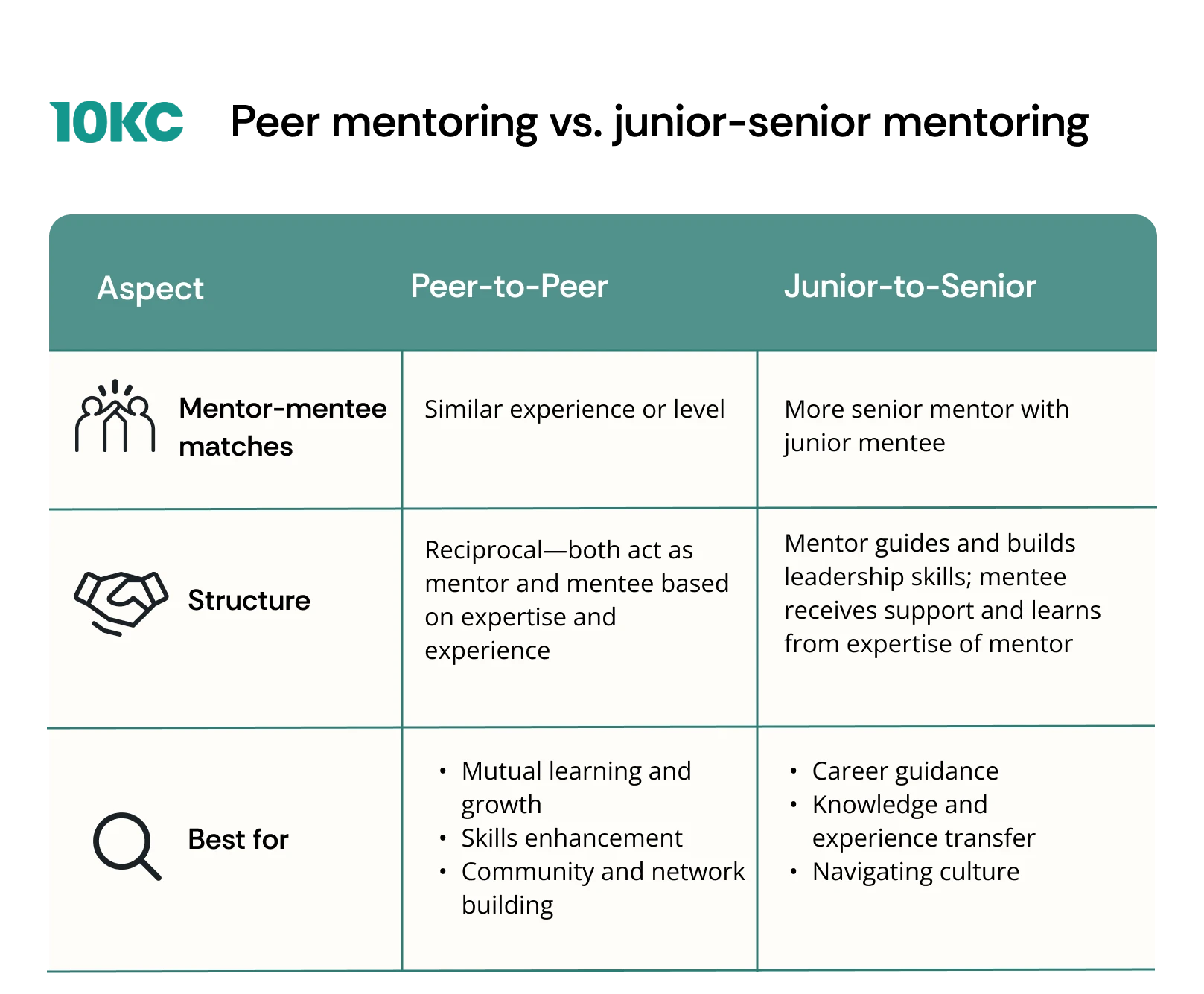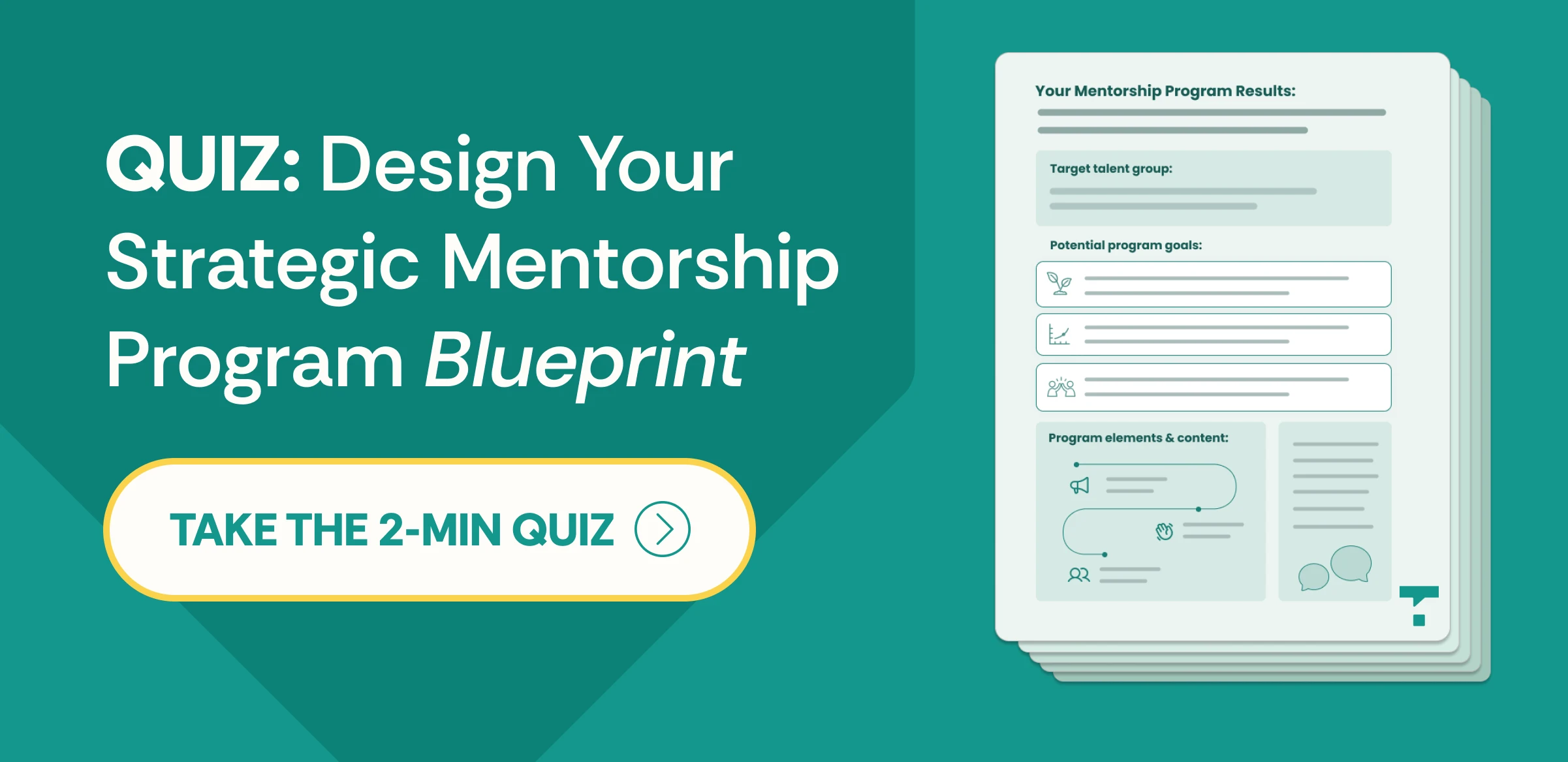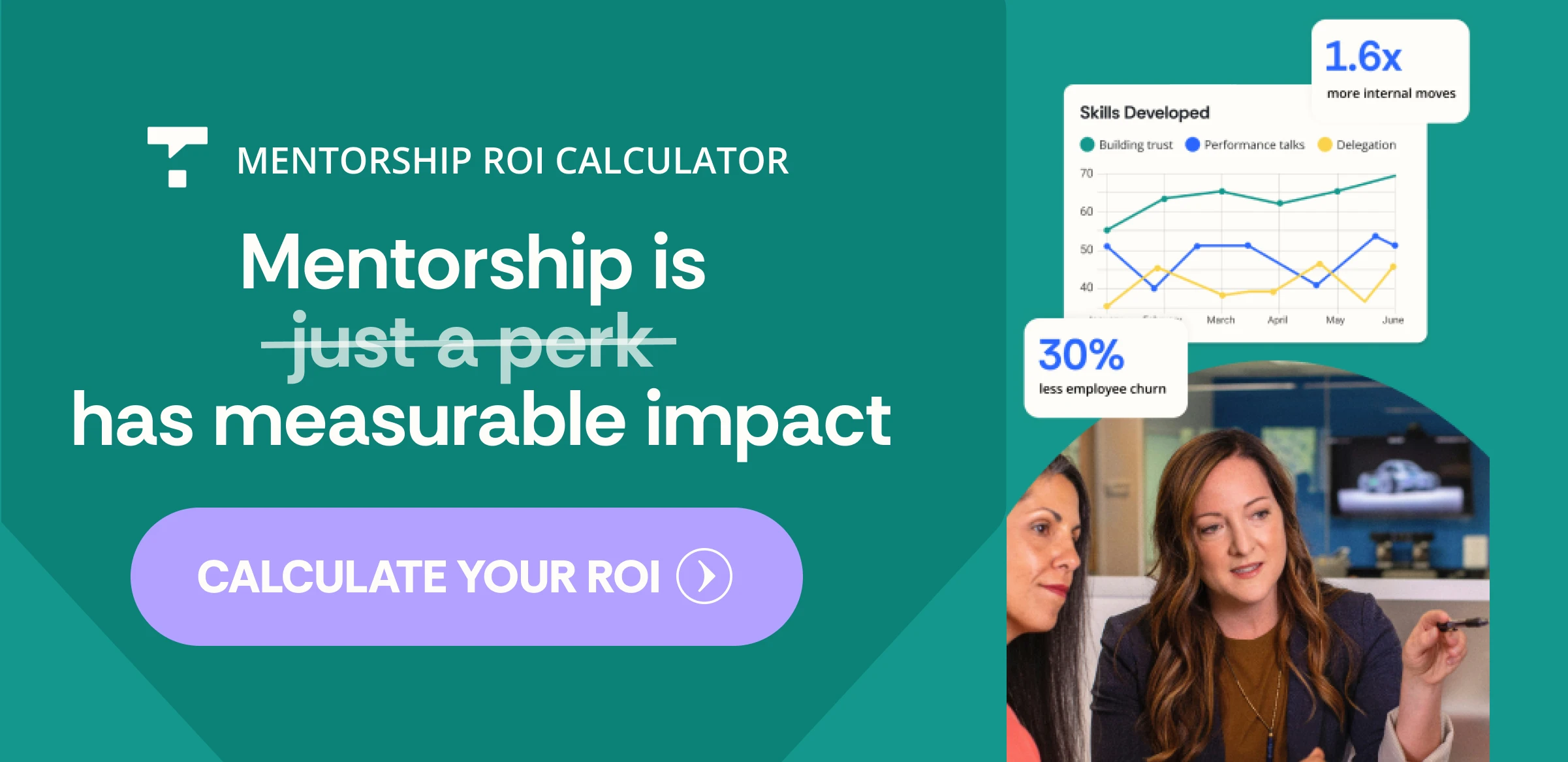When we think of mentorship, we often default to the most familiar model: junior-senior mentoring. But there are many types of workplace mentorship. One that’s often overlooked? Peer-to-peer mentorship.
Peer mentoring is a powerful model that connects employees at similar levels to foster growth and collaboration.
Instead of knowledge flowing from senior to junior, both peers engage in a naturally balanced learning experience where insights flow both ways. Rather than one person guiding the other, both peers grow together—offering support, feedback, and shared learning from a place of equality.
In this article, we’re taking a closer look at what makes peer mentoring so powerful, some examples of peer mentors in action, and how you can create a peer mentorship program that meaningfully contributes to your talent development goals.
Peer mentoring vs. junior-senior mentoring
Mentoring is rooted in growth and development, providing an opportunity for employees to learn the way they do best—from other people.
So, what makes peer-to-peer mentoring different from more common types of mentoring relationships, such as junior-to-senior mentoring?
How junior-senior mentoring works
In a junior-senior mentoring relationship, the senior individual acts as the mentor, using their experience to provide actionable guidance, support, and career advice to the more junior mentee.
While mentorship is never a one-way street, the senior mentor often has more wisdom and knowledge to impart to their mentee and takes on more of a leadership role. This makes these types of relationships incredibly valuable for employee career growth and upward skill progression.
The primary focus of junior-senior mentoring often include:
- Career guidance: Mentors can leverage their past experience and their network to support a mentee's career trajectory, providing advice, insights into organizational dynamics, and potential sponsorship.
- Knowledge and experience transfer: The mentor's accumulated wisdom, industry knowledge, and past experiences can be a valuable asset for bridging skills and knowledge gaps as employees progress in their careers.
- Navigating organizational culture: A mentor’s institutional knowledge gives them a strategic business perspective and understanding of unwritten rules and expectations that can be passed down to mentees.
How peer mentoring works
Meanwhile, peer mentorship is more of a reciprocal relationship where equals support each other. Both individuals are typically of similar experience and seniority level. Throughout the course of the mentoring relationship, either participant may step into the role of mentor or mentee based on their strengths and areas of opportunity.
Peer mentoring thrives on shared experiences and mutual learning, making it a powerful tool for ongoing career development and shared problem-solving. The dynamic is fluid—participants take turns offering guidance, asking questions, and sharing feedback.
Peer-to-peer mentorship is particularly effective for:
- Mutual learning and growth: Share insights from similar perspectives and collaborative problem-solving encourage reciprocal development.
- Skill enhancement: Peers can work together to hone specific skills, share practical tips, and learn from each other's strengths.
- Building community: Peer-to-peer mentorship creates stronger relationships and a sense of camaraderie among colleagues.

When it comes to mentorship, it doesn’t need to be one or the other. Both models serve critical roles in a well-rounded talent strategy. Peer mentoring complements traditional junior-senior mentorship by expanding access and creating new opportunities for growth.
Strategic benefits of peer mentoring
Mentoring has the potential to drive key talent outcomes, like engagement, retention, and internal mobility. And peer mentoring brings something uniquely valuable to the table.
While traditional top-down mentoring often gets the spotlight, peer mentoring offers a different kind of impact. It fosters connection, accelerates development, and strengthens culture from the inside out. Let’s break down some of the key benefits of peer-to-peer mentorship for your employees and your business.
For employees
When provided with peer mentoring opportunities, employees benefit from:
- Collaborative learning and growth: The unique nature of peer-to-peer mentorship makes it an effective approach to reciprocal development and shared insights.
- Expanded networks and relationships: Peer mentoring helps employees meet new people and grow their internal networks.
- Mentor and mentee experiences: Peer mentorship gives employees the opportunity to experience being both a mentor and a mentee, helping them develop critical leadership and skills, and the ability to be a better mentee.
- Safe learning spaces: Working with a trusted peer can create ultra-safe spaces for experimentation, learning, and honest feedback.
- Diverse perspectives: Connecting with peers across the organization helps employees access unique insights and perspectives that can spark innovation and creative thinking.
- Peer support: Building relationships with peers can give employees the confidence and validation that fosters belonging and purpose in the workplace.
For the organization
Peer mentorship, much like many strategic talent initiatives, also offers benefits to the broader business. Creating peer-to-peer mentorship opportunities empowers organizations to:
- Scale mentorship opportunities: Peer mentoring increases the supply of mentors and creates a wider participation pool, since peer mentorship doesn’t require a high number of senior mentors.
- Create a culture of learning and development: Peer-to-peer mentoring reinforces a culture of mentorship across all levels of the organization.
- Increase knowledge sharing and collaboration: Connecting employees across teams encourages the collective building and sharing of business acumen to boost overall performance.
- Drive key talent outcomes: A supportive peer network increases employee engagement, development, retention, and internal mobility.
- Encourage inter-team understanding: Broadening networks and relationships across the organization creates more collaborative and empathetic teams.
📌 READ MORE: 20 Proven Benefits of Mentoring for Employees, HR Objectives, and Your Business
Peer mentoring, your way: Formats that feed real talent needs
Peer-to-peer mentorship can come in many different shapes and sizes. When done right, it adapts to the diverse needs of your people and the evolving goals of your business. From leadership development to culture-building, the right mix of mentoring experiences can make learning more inclusive, engaging, and scalable.
Whether you’re supporting early talent, empowering people managers, or building bridges across functions, peer mentorship offers flexible formats that meet employees where they are—and help them grow into where they’re going.
Here are some of the most effective types of peer mentoring programs, plus real-world ways to bring them to life.

Experienced, 1:1 peer mentoring
The most common type of peer mentoring is 1:1, similar to traditional mentorship. It provides an opportunity for two individuals with unique perspectives and experiences to connect, exchange ideas, and offer actionable advice to help each other grow and build new skills.
Christine Silva, Talent Advisor and former leader at RBC, Catalyst, and Shopify, recommends this kind of peer mentoring when the participants have some experience with the development objectives. “Otherwise, you have a bit of a 'blind leading the blind' situation,” she shares.
Some examples of experienced peer mentoring in action can include:
- Two managers sharing effective strategies for handling team conflicts or performance management.
- Peers from different departments meeting regularly to understand how their respective areas intersect and impact the wider business strategy.
- Members of an identity group, such as women in leadership, BIPOC employees, sharing experiences and advice on career progression and navigating specific workplace dynamics.
Flash peer mentoring (topic-focused, short-term)
Flash peer mentoring, or speed mentoring, is typically a short-term relationship built around a specific topic or development opportunity. These are brief, targeted interactions designed to be concise.
Flash mentoring can be a valuable opportunity for employees to connect with multiple peers on a variety of topics in a short amount of time.
Examples of when you could use flash peer mentoring might include:
- A group of project managers sharing best practices for a specific project management software.
- Sales representatives exchanging tips on closing techniques.
- Employees in different departments giving each other feedback on presentation skills.
Group peer mentoring (learning circles)
Mentoring doesn’t have to be a one-on-one experience. Group mentoring models can expand networks and create exposure to different perspectives and knowledge within the organization in a short period of time.
“I'm a big fan of the group mentorship model when it's peers. It makes it more like a peer learning circle where everyone gives and takes equally. It also helps break the mental model of 'traditional' mentorship, where one person is supposed to have questions and the other answers. Instead, everyone's on an equal footing, with expectations that they'll both give and take.” - Christine Silva, Talent Advisor, former leader at RBC, Catalyst Shopify
Some successful examples of group peer mentoring can include:
- A cohort of new managers meeting monthly to discuss common leadership challenges and share successful approaches.
- A cross-functional group exploring best practices for implementing agile methodologies within their respective teams.
- New hire cohorts with new employees working together to navigate their onboarding.
Skills-based peer mentoring
Peer mentoring can be a great way to create a safe space for employees to get together to develop, practice, and apply new skills. Every individual has their own strengths and weaknesses, and giving opportunities for employees to share their tips and insights can accelerate development.
Examples of skills-based peer mentoring include:
- Two employees learning a new programming language pair up to code, review each other's work, and troubleshoot problems.
- Peers practicing public speaking or presentation skills.
- Peers role-playing to practice and refine their sales techniques.
Network-building peer connections
Skills and knowledge building are only one facet of mentorship. Mentoring can be a strategic lever for expanding networks and fostering belonging in an organization. By creating workplace connections through peer-to-peer mentorship, you can increase cross-departmental collaboration, reduce isolation, and boost morale among employees.
Some examples of using peer connections to build networks include:
- Pairing new hires with established peers from different departments for informal introductory chats outside of onboarding tasks.
- Structuring facilitated introductions between employees from different locations or functions, specifically to broaden networks.
- Creating connection opportunities for potentially isolated groups, such as remote employees or managers, to build community and share experiences.
Collaboration and innovation peer connections
Peers can be a source of inspiration and innovation within the organization. Peer mentoring offers structured opportunities for employees to work on joint problem-solving skills, generate ideas, and improve their processes. This cross-pollination of ideas can be a catalyst for innovation and performance.
Examples of driving collaboration and growth through peer mentoring can include:
- Forming cross-functional "tiger teams" of peers to tackle a specific business challenge.
- Pairing individuals from R&D and Marketing to co-develop ideas for product positioning.
- Bringing together customer success and product peers to surface client feedback and co-create feature improvements that better serve end users
Who should participate in a peer mentoring program?
Peer mentoring stands out as a talent development initiative because it can be adapted to the unique needs of different employees. It can be a valuable learning and growth tool for employees at all stages of their careers and the talent lifecycle.
Some examples of employees who can benefit from participating in peer mentoring include:
- New hires: Pairing new hires with tenured peers can help accelerate onboarding, integrate into company culture, and build an initial support network.
- Employees new to role: Peer mentoring can help employees who’ve recently been promoted or made a lateral move by providing role-specific insights, context, and strategies for navigating their new responsibilities.
- People managers: Create a safe space for managers to discuss challenges, share effective management techniques, combat loneliness, and build a peer support network.
- Senior leadership: Senior leaders may have limited upward mentoring opportunities. Peer mentoring facilitates strategic thinking, cross-functional perspective sharing, and support for navigating complex organizational dynamics.
- Experienced individual contributors: Enables seasoned employees (non-managers) to share deep functional knowledge, gain broader business understanding, and mentor other peers in their areas of expertise.
- Early talent: Group mentoring (learning circles) or network-building connections with colleagues can offer early talent opportunities for foundational development, peer support, and exposure without the pressure of deep individual expertise.
- Diverse talent, underrepresented groups, employee resource groups (ERGs): Peer-to-peer mentoring creates supportive spaces for sharing unique experiences, navigating specific career paths, fostering belonging, and building community.
- Employees in transition: Peer mentoring opportunities can provide stability, shared coping strategies, and peer guidance for employees navigating organizational change and uncertainty, such as reorganization and M&A.
- Employees with specific skills gaps: Mentorship can provide targeted support for skill development through practice, peer coaching, and shared learning.
- Remote or geographically dispersed employees: Peer-to-peer mentorship can build connection, combat feelings of isolation, increase visibility across locations, and create a stronger sense of belonging.
- Employees in siloed roles and departments: Cross-functional peer mentorship can build bridges across functions, enhance understanding of the wider business, and encourage collaboration.
- Very tenured employees: Peer mentorship can be an effective channel for long-term employees to transfer critical institutional knowledge, mentor newer colleagues, and even gain new perspectives from newer peers.
How to create a peer mentoring program
The most impactful peer mentoring programs require a strategic approach to create matches that deliver meaningful benefits for participants and fuel the talent outcomes that matter to your organization.
Now that you have some examples in your back pocket, use this step-by-step guide to create a successful peer mentoring program that will actually benefit your employees and your business.
1. Dive into the goals of your program
Successful mentorship programs have meaningful goals that extend beyond just ‘having a program’. This not only provides program managers with measurable outcomes to provide ROI, but it also offers a solid foundation on which to build your peer mentorship program on top of.
Peer-to-peer mentoring can be a great catalyst for talent goals such as:
- Reinforcing learning and skills development
- Enhancing cross-functional collaboration
- Supporting leadership or manager development
- Fostering a more inclusive culture
If you don’t identify an attainable and deliberate objective at the outset, it can be easy for mentorship programs to fall off track and end up being nothing more than a feel-good initiative.
📌 READ MORE: Effective Mentorship Programs Start with Strong Goals. Here's How.
2. Understand the needs of your target talent group
Mentorship is not one-size-fits-all. While the organic nature of mentoring relationships makes it easier to adapt to the needs of different employees, every employee group (and talent goal) requires diverse connections and experiences to truly move the needle.
Targeted mentoring pathways can help connect participants with the right experiences based on their development goals. It also ensures that you’re providing talent with the resources and matches that allow them to make the most of their mentoring experience.
While peer mentorship is a powerful tool for many employees, you also need to make sure it’s the right fit for your specific talent group. For example, early talent may benefit from peer mentoring when it comes to fostering culture and belonging. But when it comes to career development, more traditional junior-to-senior mentorship may be more appropriate.

3. Set clear expectations
Employees are busy, and their time is valuable. They need to know that mentorship is more than just a structured social hour. Otherwise, it’s likely to be deprioritized in favor of tasks that they feel will help them reach their goals.
Employees need to know what they’re getting out of their mentorship experience. Are they going to gain new skills? Increase visibility? Build better relationships with their peers? Setting expectations from day one gives employees something to get excited about.
Employees also need to know what’s expected of them. This can be particularly true in peer-to-peer mentorship, where the relationship often looks different than traditional mentoring. For many participants, this may be their first time stepping into this type of mentor or mentee role, and providing clear guidance can set them up for success.
4. Make meaningful matches
Everyone has something to offer. But that doesn’t mean every mentorship match is the right one either. Meaningful mentor-mentee matches are created by strategically factoring in program goals, individual needs, skills, and experience.
With peer mentoring, you need to create mutually beneficial relationships so no one is left behind. You also don’t want to end up with redundant relationships that don’t support your goals. For example, a match between two individuals with similar backgrounds and strengths is likely to be less impactful than one between two individuals whose strengths complement each other.
Tip: Smart matching algorithms can take the manual work out of mentor-mentee matching, so you can create strategic matches that work at scale.
📌 READ MORE: Mentorship Matchmaker: How to Strategically Match Mentors and Mentees
5. Gently guide conversations and discussions
Peer mentoring conversations should have a purpose. Otherwise, it’s just a casual coffee chat.
Discussion guides can prevent any early-stage awkwardness and help keep discussions on track. They’re helpful for keeping conversations focused on developing and practicing new skills. Discussion guides can also be a medium for sharing helpful, expert-backed resources that spark insightful conversations.
6. Mix up your peer mentoring experiences
We might sound like a bit of a broken record, but the best mentorship programs offer a variety of mentoring experiences. One-on-one peer mentoring is only one way to help employees learn and grow.
Leverage a mix of one-on-one mentoring, peer learning, group learning, and junior-to-senior mentoring to help your organization and your participants make the most of their mentorship experience.
7. Create opportunities for feedback and recognition
Take the time to listen to your participants. What’s working? What’s not? Surveys throughout and post-program can offer insight into what optimizations can be made to help your peer-to-peer mentoring program reach its full potential.
And of course, take the time to help mentors and mentees celebrate their development wins too.
8. Report on ROI
For many mentorship programs, the true impact is stuck in spreadsheets. It leaves program managers and stakeholders underestimating the ROI. Take the time to gain visibility into mentoring data and the metrics that matter to the business—from engagement and development to mobility and retention.
The right mentorship software can offer robust reporting and analytics so you can track the connections and learnings in real time to uncover and share the real value of peer mentoring.

📌 READ MORE: How to Measure the Business Impact of Corporate Mentorship Programs
Create and scale peer-to-peer mentoring with 10KC
10KC’s mentoring platform helps leading organizations build winning talent development strategies. From smart-matching to personalized pathways, 10KC is your partner in creating multidimensional peer mentoring experiences that drive engagement, retention, and promotion at scale.
FAQs
What is a peer mentor?
A peer mentor is someone in the workplace who provides guidance, advice, and support to another employee at an equivalent experience level. In peer mentoring, the dynamic is fluid and thrives on shared experiences and mutual learning. The goal of a peer mentor is to provide mutually beneficial social learning and development opportunities for employees.
What is the difference between mentoring and peer mentoring?
Peer mentoring is a type of mentoring. But it’s a bit different from what we’d consider a more traditional mentor-mentee relationship. Rather than pairing a junior mentee with a senior mentor, peer mentoring pairs two individuals of similar level and experience so they can share knowledge and insights. While mentoring should always be a two-way street, peer mentoring is even more of a reciprocal relationship where learning and development are equally bilateral.
What is peer-to-peer coaching?
Peer-to-peer coaching is a two-way social learning experience where individuals can exchange expertise in the workplace. Instead of solely relying on senior employees coaching more junior employees, peer-to-peer coaching recognizes that every employee brings unique experiences, skills, and strengths to the table that can be leveraged as a development opportunity among the people they work with.
What skills are needed to be a peer mentor?
The skills needed to be a good peer mentor include effective communication, a willingness to learn, and providing constructive feedback. Peer mentorship is also a dynamic solution that helps employees hone the skills they need to be better mentors and mentees down the road, such as leadership, strategic thinking, empathy, and problem-solving.









.png)